#Bibliographisches Institut
Explore tagged Tumblr posts
Text






A Lunch-Time Feathursday
Yep, just as our header suggests -- and getting progressively more gruesome. These images are reproduced from paintings by the German wildlife artist Wilhelm Kuhnert (1865-1926) from the second volume in Brehms Tierbilder, published in Leipzig and Vienna by Bibliographisches Institut in 1913.
Shown here from top to bottom are group of non-European finches, a Eurasian Jay (Garrulus glandarius), a Eurasian Eagle-Owl (Bubo bubo), a Golden Eagle (Aquila chrysaetos), a Gyrfalcon (Falco rusticolus), and a couple of Marabou Storks (Leptoptilos crumeniferus).
Bon appetit!
View more Feathursday posts.
#Feathursday#Brehms Tierbilder#Wilhelm Kuhnert#wildlife artists#Bibliographisches Institut#finches#Eurasain Jay#Eurasian Eagle-Owl#Golden Eagle#Gyrfalcon#Marabou Stork#birds#birbs!#lunch
105 notes
·
View notes
Text

"Queen of the Night"
Selenicereus pteranthus, known as "queen of the night" or "princess of the night" is a night-blooming cactus.
This week's HSA Sunday Garden features SciArt found in The Natural History of Plants, Vol. 1 (1894) by Anton Kerner von Marilaun, translated by F. W. Oliver with the assistance of Marian Busk and Mary F. Ewart. This particular image was printed from the original by Ernst Friedrich Heyn held by the publishing company, Bibliographisches Institut in Leipzig, Germany.
View more in Biodiversity Heritage Library with thanks to the Mertz Library of the New York Botanical Garden for digitizing.
#cactus#night blooming cactus#queen of the night#princess of the night#histsciart#sciart#naturalhistory#biodiversity heritage library#flowers#nybg#flower art#flowercore
288 notes
·
View notes
Photo

Illustration depicting electrical discharge, published by the German publishing company Bibliographisches Institut, 1909.
Available as a print from our shop here: https://t.co/ththht0VPI
Last order dates for pre-Dec 25th delivery here: https://publicdomainreview.org/blog/2024/11/last-order-dates-for-christmas-2024/
208 notes
·
View notes
Photo

🕷 Die Insekten, Tausendfüssler und Spinnen. Leipzig, Bibliographische Institut, 1877.
92 notes
·
View notes
Text

Die Vögel (Leipzig, Bibliographisches Institut, 1913) | Alfred Edmund Brehm (1829-1884) | Biodiversity Heritage Library
#alfred edmund brehm#biologie#ornithologie#vögel#biodiversity heritage library#buch#german books#vintage books#curators on tumblr#books#illustrated nature books#nature books
1 note
·
View note
Text

Brehms Tierleben Leipzig, Bibliographisches Institut, 1911-19
1 note
·
View note
Text

Blättern
1.
Man muss Diagnosen schon ernst nehmen, macht nur keinen Sinn, sich darauf auszuruhen. Es macht keinen Sinn, sich in den hochgefahren Betrachtungen, die man Pathologie nennt und die überhaupt dasjenige sind, an dem die Kulturtechnik der Diagnose sich entwickelt hat, einzurichten. Man soll nämlich weiter, treibt ja alles weiter, da muss man mit.
Angeblich sei ich jetzt in der Bewegung eingeschränkt. Das Bein, das Fußgelenk, ist bist auf weiteres fixiert, in einem Stiefel, der von Designern stammen könnte, die um 1990 den Innenraum eines Daihatsu und um 2000 herum sinnlose und wegeschmeissbare Möbel für Möbel Maxxx gestaltet haben. Der Fuß soll nicht belastet oder bewegt werden. Aber der Kosmos ist keine Einbahnstraße. Der Urknall hat schließlich überall stattgefunden, der Kosmos expandiert nicht nur als Vergrößerung, nicht nur ins immer Grössere hinein. Der Kosmos geht auch ins Mikro, auch ins Kleine rein gehen die Richtungen und Expansionen. In den nächsten Tagungen laufen meine Bewegungen eher ins Kleinere hinein, ich mache meine Welt- und Zeitreisen von einer Matratze aus in die Entfernungen dessen, was zum Übersehen naheliegt.
In der Bibliothek zuhause stehen alle die Bücher, die ich nicht ins Institut geschleppt habe. In denen kann ich jetzt stöbern, d.h. in derjenigen Literatur, die mir, seitdem ich in meinem Bett aus unruhigen Träumen erwachte und mich in einen ungeheuren Staatsrechtslehrer verwandelt sah, plötzlich nicht mehr so wichtig oder nur noch privat erschien. Dabei ist eine private Praxis öffentlicher Dinge ohnehin ein Teil meiner Forschung.
2.
Schnie, schnah, schnappi, schnappi, schnapp, schnapp: Boris Groys' Unter Verdacht muss ich 2001/ 2002 hektisch überflogen und bekritzelt haben (siehe oben). Kann mich an kein Wort mehr erinnern, habe aber viel drin gekritzelt. Weiß nur noch, dass ich mal mit Vesting auf der Autobahn zwischen Augsburg und München darüber unterhalten habe, wir fuhren zum Arri- Kino, um einen Vortrag von Jean Baudrillard zu hören. Sonst weiß ich nix mehr.
Im Zettelkasten: nur bibliographische Angaben, sonst nix: keine Exzerpte, keine Verweise, keine Paraphrasen und keine Kommentare. Und dann noch beim Umzug ins Institut stehen gelassen, im Gegensatz zu seinem Essay über das Neue. Der immerhin ist einer der Anlässe gewesen, das Archiv der enttäuschten Erwartung zu gründen.
3.
Viel wichtiger: Vor mir aufgehäuft, inzwischen riesig: Texte, die abzugeben sind. Meine Vorstellung ist paradiesisch fies: ich müsse mich da durchfressen, wie durch den Puddingberg, durch den diejenigen müssen, die ins Schlaraffenland, dem miesen Futterpark unter den Paradiesen wollen. Da löffel und löffel ich
1 note
·
View note
Photo

Bibliographisches Institut
22 notes
·
View notes
Photo

“The flagellants at Doornik (Tournai) in 1349 From the caption: Printed by the Bibliographisches Institut, Leipzig. THE FLAGELLLANTS AT DOORNIK IN 1349. MINIATURE FROM THE CHRONICLE OF AEGIDIUS LI MUISIS IN THE LIBRARY AT BRUSSELS. (After Paul Fredericq, “De secten der Geeselaars en der Dansers in de Nederlanden tijdens de 14de eeuw”.) That source indicates that the portion of the Gothic-lettered Latin text from the original source is only partial. They render the text as:
Accidit anno predicto quod in die assumptionis virginis gloriose venerunt a vill brugensi circiter CC homines, quasi ora [prandii. Ipsi autem adunaverunt se i foro, et statim rumor magnus fuit per totam civitatem, unde omnes veniebant. Catervatim venerunt ad locum supradictum, quia super hoc rumores audeirant et idcirco factum videre affectabant. Illi autem de Brugis interim se preparaverunt et ritum suum, quam penitantiam vocabant, facere inceperunt. Pupulus autem utriusque sexus, qui nunquam talk quid viderant,] ceperunt compati personis et penitentie condolore et deo gratias reddere super tanta penetencia quam gravissimam re[putabant. Remanseruntque dicti Brugenses in civitate tota illa die et nocte. … translated there as: In the aforesaid year it came to pass that on the day of the Assumption of the Blessed Virgin (Aug. 15) some 200 persons came here from Bruges about noon. These remained assembled on the market-place, and immediately the whole town was filled with curiosity as to why these folk had come. The burgesses came in small bodies to the market-place when the heard the news in order to convince them of the fact by their own eyes. Meantime the folk from Bruges prepared to perform their cememonies which they called “penance”. The inhabitants of both sexes, who had never before seen any such thing], began to imitate the actions of the strangers, to torment themselves also by the penitential exercises and to thank God for this means of penance which seemed to them most effectual. And the people from Bruges remained in the town the whole of that day and night.” Source
5 notes
·
View notes
Photo










Illustrations of Insects in natural habitats taken from ‘Brehms Tierleben’ by Otto Zur Strassen.
Published 1915 by Bibliographisches Institut.
Smithsonian Libraries
archive.org
65 notes
·
View notes
Audio
Teil 3 a / 5
Die Geschichte wird am Mittwoch, dem 06. Januar um 17.30 Uhr fortgesetzt!
Fremdwort-Glossar:
just: geradem, genau, eben; Esse: Schornstein; Fabrikschlot; Wildbret: wild; verbrämen: am Rand, Saum mit etwas versehen, was zieren, verschönern soll; apoplektisch: zu einem Schlaganfall gehörend, davon zeugend, damit zusammenhängend; durch einen Schlaganfall bedingt; Brignolen: geschälte und an der Luft getrocknete Pflaume; Fanatismus: rigoroses, unduldsames Eintreten für eine Sache oder Idee als Ziel, das kompromisslos durchzusetzen versucht wird
Gelesen / Bearbeitet / Regie geführt von: Sebastian Fuchs
Zitiert aus der Online-Ausgabe des Duden, erschienen im Verlag Bibliographisches Institut GmbH, abgerufen im Oktober 2020
Stefan Zweig, Schachnovelle wurde mir bereitgestellt von dem Gutenberg-Projekt-DE, abgerufen im Oktober 2020
#literatur#literature#World Literature#weltliteratur#literaturfuxx#Lesen#Leseratte#lesenswert#Vorlesen#lesenmachtspaß#lesenlesenlesen#Lesetipp#lesezeichen#leseliebe#vorlesung#Buchvorstellung#Vorlesetag#Vorlesebuch
2 notes
·
View notes
Photo
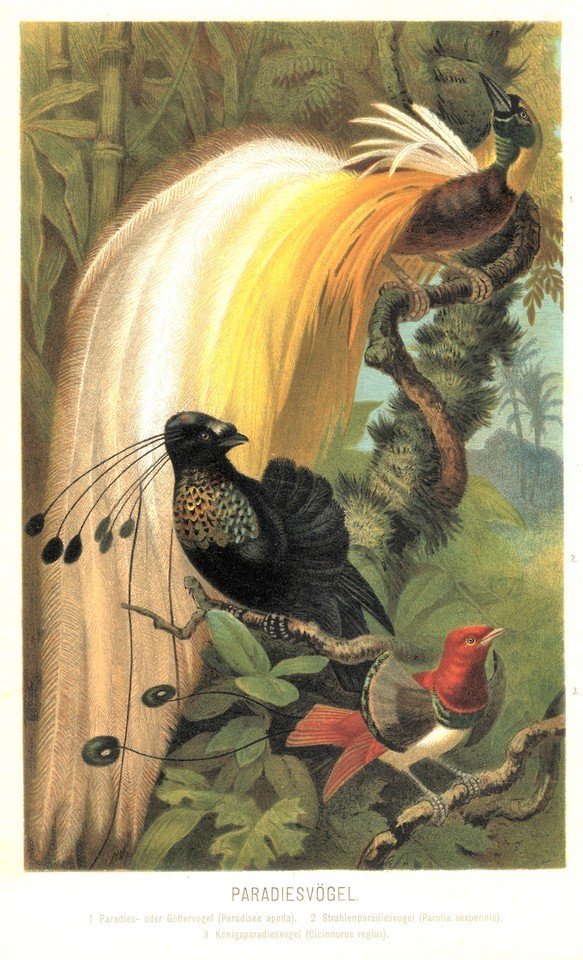
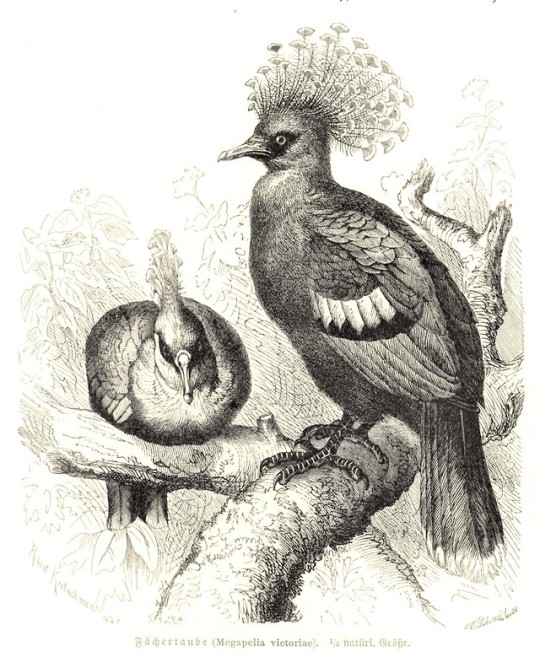
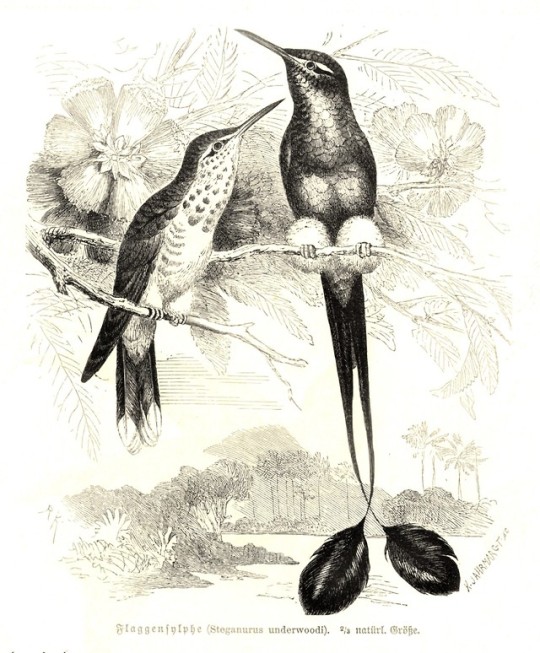
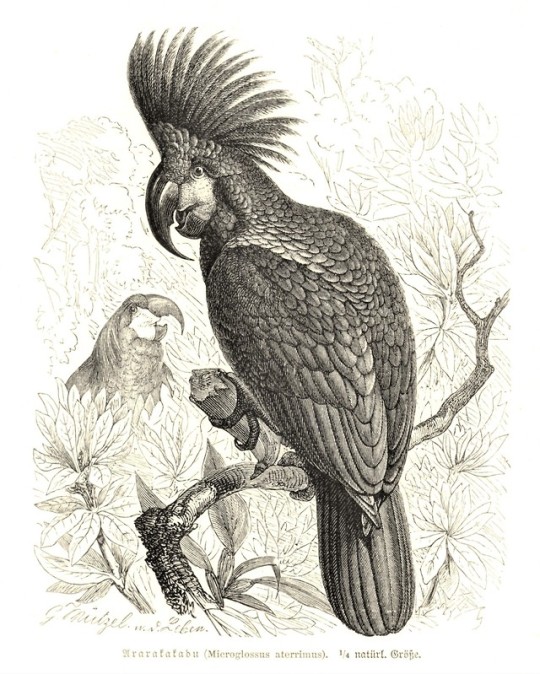
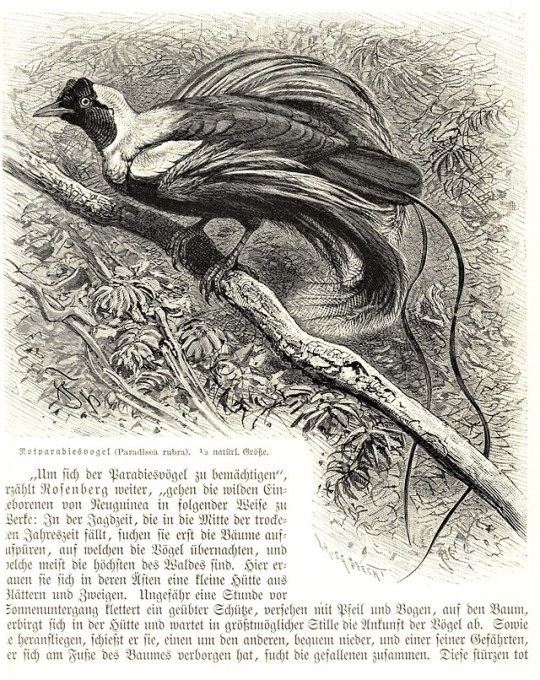


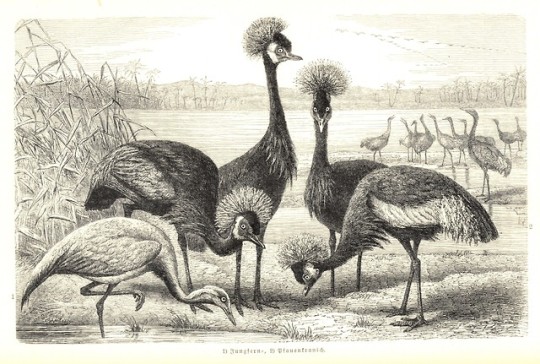
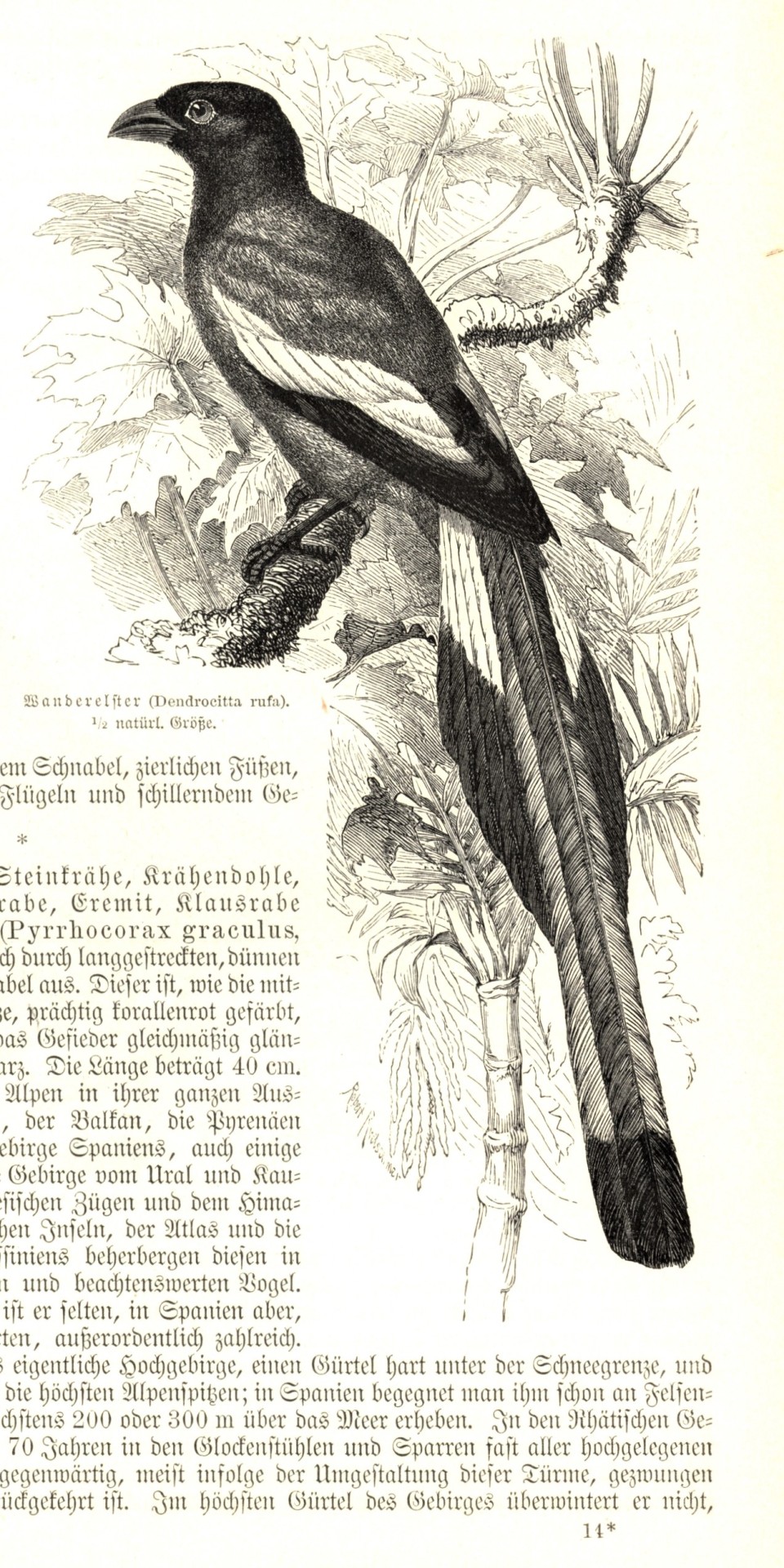

A Few Fancy Feathers for Feathursday
Here are some fancy-feathered fellows from volume two of the second edition, newly revised by Richard Schmidtlein, of Brehms Thierleben published in Leipzig and Vienna by Bibliographisches Institut in 1900. The chromolithograph of the Birds of Paradise is the only color image in this volume and serves as the frontispiece. The wood engravings were made from illustrations by naturalist artists Robert Kretschmer, Wilhelm Kuhnert, Gustav Mützel, and Friedrich Specht, From top to bottom we have:
Birds of Paradise: Greater Bird-of-Paradise (Paradisaea apoda) Six-Plummed Bird-of-Paradise (Genus Parotia) King Bird-of-Paradise (Cicinnurus regius) Victoria Crowned Pigeon (Goura victoria) White-booted Racket-tail (Ocreatus underwoodii) Palm Cockatoo (Probosciger aterrimus) Red Bird-of-Paradise (Paradisaea rubra) Pennant-winged Nightjar (Caprimulgus vexillarius) Black Sicklebill (Epimachus fastosus) Crowned Cranes (Genus Balearica) Rufous Treepie (Dendrocitta vagabunda) Indian Peafowl (Pavo cristatus)
View more posts from other editions of Brehms Thierleben.
View more Feathursday posts.
#Feathursday#fancy feathers#Brehms Thierleben#Richard Schmidtlein#Bibliographisches Institut#Robert Kretschmer#Wilhelm Kuhnert#Gustav Mützel#Friedrich Specht#birds of paradise#pidgeons#hummingbirds#cockatoos#nightjars#cranes#treepies#peacocks#wood engravings#chromolithographs#Yay chromoliths!#birds#birbs!
70 notes
·
View notes
Text

"Tropical Epiphytes in Ceylon"
Epiphytes, commonly known as air plants, grow on other plants, known as phorophytes, and get their nutrients and water from the air, rain, or debris surrounding it. This illustration shows a variety of epiphytes growing in a forest of Sri Lanka, which is historically known as Ceylon.
This week's HSA Sunday Garden features SciArt found in The Natural History of Plants, Vol. 1 (1894) by Anton Kerner von Marilaun, translated by F. W. Oliver with the assistance of Marian Busk and Mary F. Ewart. This particular image was printed from the original held by the publishing company, Bibliographisches Institut in Leipzig, Germany.
View more in Biodiversity Heritage Library with thanks to the Mertz Library of the New York Botanical Garden for digitizing.
#HSA Sunday Garden#histsciart#sciart#biodiversity heritage library#naturalhistory#flowers#flowercore#epiphytes
79 notes
·
View notes
Photo

Illustration depicting electrical discharge, published by the German publishing company Bibliographisches Institut, 1909.
Available as a print from our shop here: https://t.co/ththht0VPI
Last order dates for pre-Dec 25th delivery here: https://publicdomainreview.org/blog/2023/11/last-order-dates-for-christmas-2023/
186 notes
·
View notes
Photo

🦄 Brehms Tierleben Leipzig, Bibliographisches Institut, 1911-19-
53 notes
·
View notes
Text

Die Insekten, Tausendfüssler und Spinnen (Leipzig, Bibliographisches Institut, 1877) | Alfred Edmund Brehm (1829-1884) | Biodiversity Heritage Library
Pl 01 | Insektenleben am Heidekraut Pl 02 | Käfer in Wassersnot Pl 03 | Wirkungen Vereinter Kräfte Pl 04 | Aasinsekten an einem Maulwurfe Pl 05 | Hirschkäfer und Heldbock Pl 06 | Herkuleskäfer Pl 07 | Frühlingsbild aus dem Insektenleben Pl 08 | Bienentraube Schwarm Pl 09 | Rothe Waldameise Pl 10 | Deutsche Tagfalter Pl 11 | Seidenspinner Pl 12 | Heerwurm Pl 13 | Herrschaft der Fliegen Pl 14 | Eintagsfliegen Pl 15 | Eierlegende Schlankjungfer Pl 16 | Termitenhugel in Sennar Pl 17 | Schwarm der Wanderheuschrecke Pl 18 | Nächtliches treiben der Insekten Pl 19 | Ausländische Zirpen Pl 20 | Deutsche Wasserwanzen und Wasserläufer Pl 21 | Vogelspinne
#alfred edmund brehm#biologie#entomologie#insekten#buch#books#german books#vintage books#biodiversity heritage library#curators on tumblr#illustrated nature books#nature books
1 note
·
View note